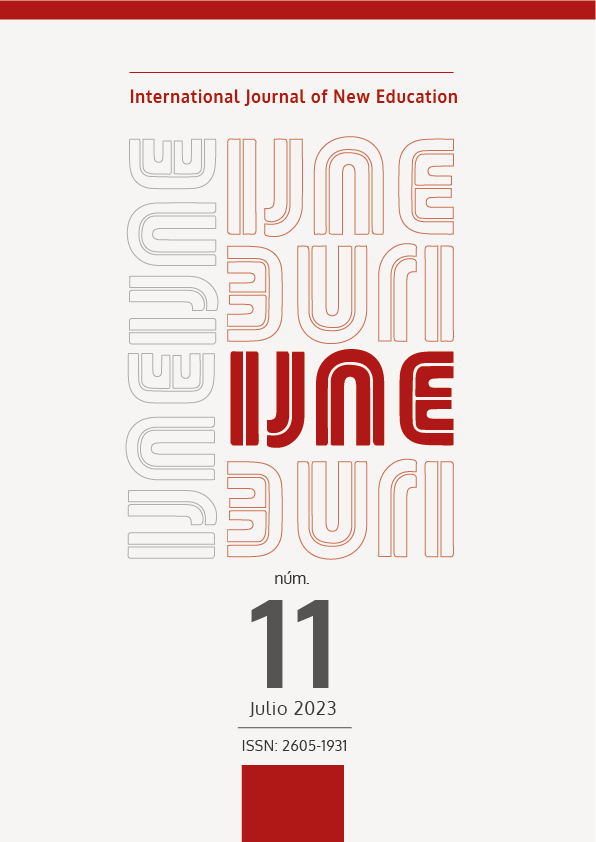El impacto del clima escolar sobre la violencia en centros árabes de Jerusalén: perspectiva del profesorado
DOI:
https://doi.org/10.24310/IJNE.11.2023.16443Keywords:
school violence, classroom environment, teachersAbstract
School violence constitutes one of the central issues on public agenda in Israel and multiple other countries, since the figure of those students involved in such violence is considerable high according to international standards. The aim of this study is to examine the teachers' perceptions of the impact of educational climate on reducing violence in Arab schools in Israel. The tools used to collect data were a questionnaire and a semi-structured interview. 352 teachers participated in the study: the number of participants filling in the school climate questionnaire was 302 and the number of participants in the interview were 50 teachers. All the participants in the study are from East Jerusalem and work in both state and private Arab schools. The findings of the study indicate that, according to the teachers’ opinions, there is a positive relationship between maintaining an optimal educational climate and the reduction of violence in the Arab schools.
Downloads
Metrics
Publication Facts
Reviewer profiles N/A
Author statements
Indexed in
-
—
- Academic society
- N/A
- Publisher
- Universidad de Málaga
References
Abu-Esba, H. (2007). Arab education in Israel: dilemmas of a national minority. Jerusalem: Florsheimer Institute for Policy Studies.
Abu-Saad, I. (2006). State-Controlled Education and Identity Formation Among the Palestinian Arab Minority in Israel. American Behavioral Scientist, 49(8), 1085-1100. https://doi.org/10.1177/0002764205284720
Ali, G. (2014). Violence and crime in Arab society in Israel: institutional conspiracy or cultural crime?
Bar-Lev, A. (2007). School climate: reality and vision. Beer-Sheva, Israel: The National Center for Further Education of Teaching Staff in the Fields of Spiritual and Social Judaism “Stable House”.
Bar-Maoz, T. (2008). Show me the website of your school and I will tell you about its organizational culture. Reviews of Education in Society in Technology and in science, 7, 20-24.
Benbenisti, R., Huri-Kasabri, M. & Astor, R. (2005). Violence in the educational system 2003: summarizing findings report. Jerusalem: Social Work Faculty, Hebrew University in Jerusalem
Cozma, I., Kukaswadia, A., Janssen, I., Craig, W., & Pickett, W. (2015). Active transportation and bullying in Canadian schoolchildren: a cross-sectional study. BMC Public Health, 15(1), 1-7.
HajYahia-Abu Ahmad, N. (2006). Zogiot ve horot ba meshpaha ha araviet ba Israel: Tahlekhi shenoi ve shimor ba shlosha dorot
Haj Yahya’, N., Seif, A., Kasir, N. & Paragon, K. (2021). Education and training in Arab society - gaps and buds of change.
Hannah, R. (2013). The effect of classroom environment on student learning.
Henry, S. (2000). What is school violence? An integrated definition. The annals of the American academy of political and social science, 567(1), 16-29.
Kuperminc, G. P., Leadbeater, B. J., & Blatt, S. J. (2001). School social climate and individual differences in vulnerability to psychopathology among middle school students. Journal of School psychology, 39(2), 141-159.
O’Brennan, L. M., Bradshaw, C. P., & Furlong, M. J. (2014). Influence of classroom and school climate on teacher perceptions of student problem behavior. School mental health, 6, 125-136.
Pellegrini, A. D., & Long, J. D. (2002). A longitudinal study of bullying, dominance, and victimization during the transition from primary school through secondary school. British journal of developmental psychology, 20(2), 259-280.
Reyes, M. R., Brackett, M. A., Rivers, S. E., White, M., & Salovey, P. (2012). Classroom emotional climate, student engagement, and academic achievement. Journal of educational psychology, 104(3), 700.
Ryan, R. M., & Deci, E. L. (2000). Self-determination theory and the facilitation of intrinsic motivation, social development, and well-being. American psychologist, 55(1), 68.
Sezer, Ş. (2021). Teacher-induced violence in the classroom and its effects on the development of students: A phenomenological analysis. Kuram ve Uygulamada Egitim Yönetimi Dergisi, 27(1), 945-966.
Shadmi, H. (2004). The counselor and promotion of optimality, in: R. Erhard & A. Klingman (Eds.), Education counseling in school in a changing society. Ramot publication, Tel-Aviv University, pp. 343-366
Sheaf, M. (2015). Improving classroom climate through a social intervention initiative.
Tzafroni, A. (2008). Organizational culture of the school: its characteristics and contribution to the effectiveness of the school. Studies in education in society in technology and science, 7, 3-8.
Downloads
Published
How to Cite
Issue
Section
License
Las obras se publican en edición electrónica bajo una licencia Creative Commons Reconocimiento-NoComercial 4.0 España: se pueden copiar, usar, difundir, transmitir y exponer públicamente, siempre que:
a) Se cite la autoría y la fuente original de su publicación (revista,
editorial y URL de la obra.
b) No se usen para fines comerciales.
c) Se mencione la existencia y especificaciones de esta licencia de uso.
Será responsabilidad exclusiva de los autores obtener los permisos necesarios de las imágenes que estén sujetas a derechos de autor.










16.png)
